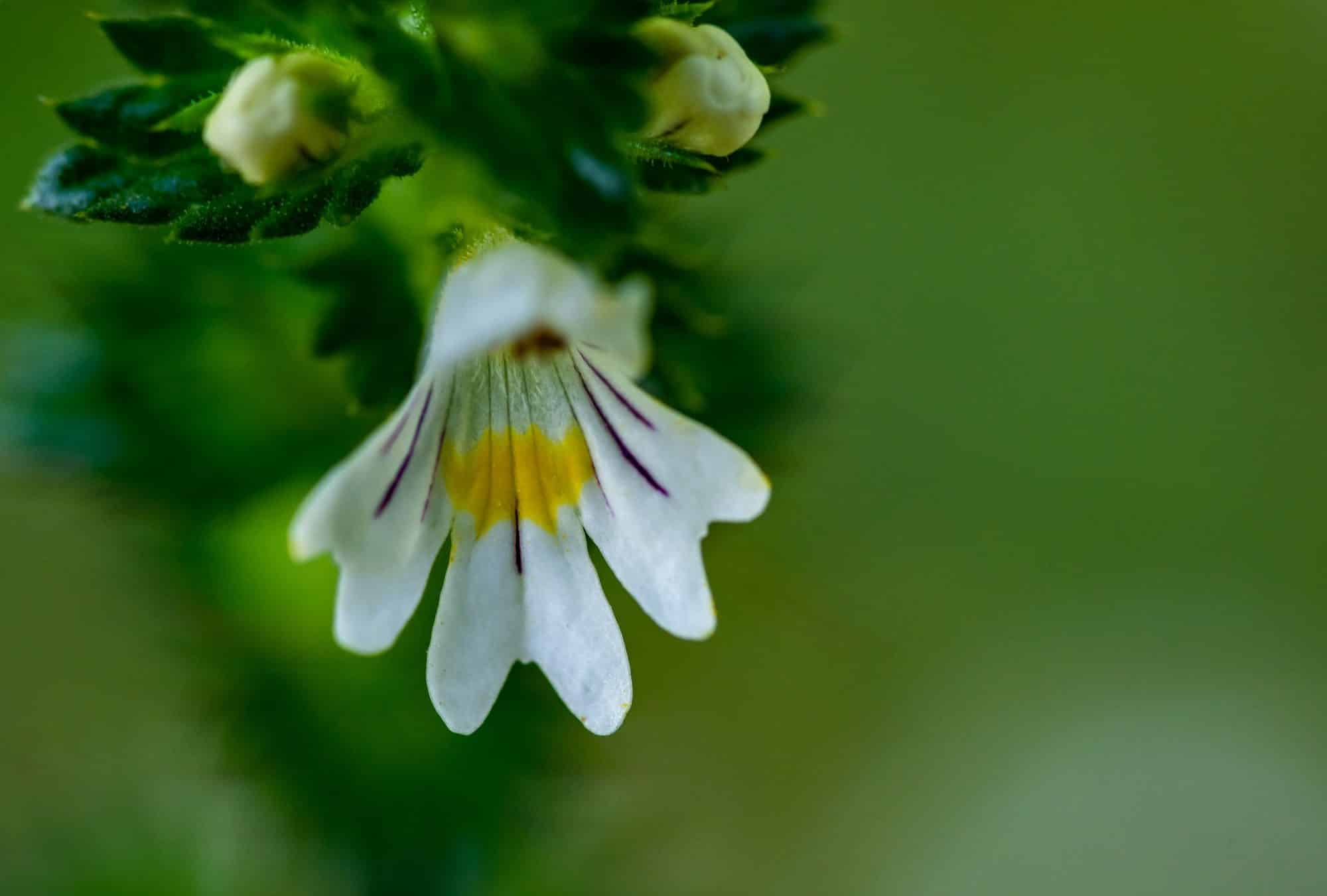-
How does it feel?
Mildly bitter, cooling, astringent with fresh subtle floral / aromatic tones and after a hint of almond. Energetically eyebright is cooling and astringent, working to tone the mucous membranes.
-
What can I use it for?
 Eyebright is a great medicine for any herbal first aid kit, it can be used for all the ages to treat mild allergy symptoms such as eye inflammation, watery eyes, itchy nose and sneezing.
Eyebright is a great medicine for any herbal first aid kit, it can be used for all the ages to treat mild allergy symptoms such as eye inflammation, watery eyes, itchy nose and sneezing.Both an antihistamine, astringent and anti-inflammatory, eyebright is used as an internal medicine (tea, tincture, capsule) and is excellent for treatment of catarrh, hay fever, chronic sneezing and inflammation in the nasal mucosa.
It is used for reducing inflammation and toning the mucous membranes, Eyebright is a highly effective medicine for use in conjunctivitis and for other acute inflammations of the eye, and can be used as eye drops or as an eye bath.
It is also useful for chronic sinusitis, nasopharangeal catarrh, serous otitis media, pharyngitis, conjunctivitis, blepharitis, catarrhal deafness and sinus headache.
-
Into the heart of eyebright
 Eyebright is a beautiful floral medicine with a long history of use for eye conditions. It is considered most specific to the eyes and was highly regarded by Herbalists of the sixteenth century.
Eyebright is a beautiful floral medicine with a long history of use for eye conditions. It is considered most specific to the eyes and was highly regarded by Herbalists of the sixteenth century.Eyebright is used in all manner of eye conditions, as previously mentioned. It acts specifically on the mucous lining of the eyes and upper respiratory tract. Therefore it offers fast symptom relief for excess secretions relating to hay fever and air borne allergies.
Grieve (1984) mentions eyebright is not only to treat disease of the eye, but also as a tonic to this delicate sensory system, stating that there is some tradition to use as an occasional eye bath purely for its ability to tone the tissues, possibly helping to aid in dimness of sight.
Eyebright has a cooling effect, and in terms of Traditional Chinese Medicine, is considered sour- cooling and in action it offers a level of reduction in liver heat, this could also be backed by the presence of bitter constituents as bitter constituents directly increase liver function.
-
Traditional uses
 Eyebright has a long-standing use in herbal medicine and early records from the 14th century suggest it was used to ‘cure all evils of the eye’.
Eyebright has a long-standing use in herbal medicine and early records from the 14th century suggest it was used to ‘cure all evils of the eye’.It was used for the treatment of eye conditions such an infections, conjunctivitis and blepharitis.
It has been used for a manner of mucous diseases, where stagnation and excess mucous present as symptoms.
Its ability to counter catarrh means it is often used for infectious and allergic conditions affecting the eyes, middle ear, sinuses and nasal passages. It seems to be a plant that has an infinity to the sensory organs of the head.
-
Traditional actions
Herbal actions describe therapeutic changes that occur in the body in response to taking a herb. These actions are used to express how a herb physiologically influences cells, tissues, organs or systems. Clinical observations are traditionally what have defined these actions: an increase in urine output, diuretic; improved wound healing, vulnerary; or a reduction in fever, antipyretic. These descriptors too have become a means to group herbs by their effects on the body — herbs with a nervine action have become the nervines, herbs with a bitter action are the bitters. Recognising herbs as members of these groups provides a preliminary familiarity with their mechanisms from which to then develop an understanding of their affinities and nuance and discern their clinical significance.
-
Traditional energetic actions
Herbal energetics are the descriptions Herbalists have given to plants, mushrooms, lichens, foods, and some minerals based on the direct experience of how they taste, feel, and work in the body. All traditional health systems use these principles to explain how the environment we live in and absorb, impacts our health. Find out more about traditional energetic actions in our article “An introduction to herbal energetics“.
Western energetics
-
What practitioners say
 Respiratory system
Respiratory systemEyebright is used for all manner of conditions relating to the nasal passages, allergic rhinitis, asthma and the common cold especially where excess mucous is a presenting symptom (2,3).
Both an antihistamine, astringent and anti-inflammatory, eyebright as an internal medicine (tea, tincture, capsule) is excellent for treatment of catarrh, hay fever, chronic sneezing, inflamed nasal mucosa, relaxed tonsils and sore throat, including where these symptoms are caused by allergy.
Specifically used to protect the eyes and mucosa during the catarrhal phase of measles, to avoid future problems (1,2).
Immune system
Eyebright is used for treating both infectious & allergic conditions affecting eyes, middle ear, sinuses & nasal passages.
Eyes
Due to its astringency and anti-inflammatory actions, eyebright is an effective treatment for conjunctivitis as an eye bath. It is also traditionally used in blepharitis, red eye, stye, for poor visual acuity due to eyestrain or diabetes and corneal opacity (1,3,5,6).
Skin
By alleviating oxidative stress, eyebright can be used topically, particularly to support cellular health following prolonged exposure to ultraviolet light (4).
-
Research
 In an in vitro study an extract of eyebright displayed cellular protection against UVB-induced photoaging by suppressing oxidative stress, cell apoptosis and inflammation. This preliminary study demonstrates the protective effects of E. officinalis against UVB-induced photoaging (4).
In an in vitro study an extract of eyebright displayed cellular protection against UVB-induced photoaging by suppressing oxidative stress, cell apoptosis and inflammation. This preliminary study demonstrates the protective effects of E. officinalis against UVB-induced photoaging (4).An in-vitro study analysing the activity of extracts of eyebright on cultured human corneal epithelial cells concluded promising effects in its application as treatment for eye disorders (5,6).
A number of compounds found in high concentration in eyebright, namely aucubin have been subject to extensive research, findings show anti microbial, hepatoprotective, antitumor and neuroprotective activity. Aucubin is found also in Ribwort Plantain (1).
It must be noted that despite longstanding traditional use, clinical trials on eyebright are limited and more research needs to be conducted. In vitro studies are not always a good reflection of the medical efficacy of a plant as results do not always translate into people. Nonetheless traditional use is a valid form of evidence too.
-
Did you know?
Eyebright was used by Ancient Greek physician Dioscorides for eye infections when accompanying Roman legions through many countries.
Additional information
-
Botanical description
Eyebright is a semi parasitic annual plant that grows wild in grasslands, meadows, heaths, and pastures of Britain, Northern Europe, Western Asia and North America. Eyebright grows to a height of 4-8 inches (10-20 cm) and has small axillary odourless flowers which are usually white with purple streaks, red spots and a yellowish palate.
The leaves are opposite, ovate or cordate and strongly ribbed.
By the doctrine of signatures (a concept that states that botanical features of herbs may indicate their therapeutic applications) the petals of eyebright resemble bloodshot eyes, suggesting the plant’s name and its eye-clearing action. Downy hairs cover the stems, which produce toothed leaves.
-
Common names
Euphrasia (deriving from the Greek word euphrosyne meaning ‘gladness’.
The name eyebright both relates to the eye like appearance of the flower and its historic use in treatment of eye conditions.
-
Safety
Eyebright is safe to use long term, there are no reported interactions or contraindications (1).
-
Dosage
Internal use: infuse 2-4g of dried herb in hot water, strain and drink. Up to three times daily.
Take 2-6ml of 1:5 tincture three times daily.
External use: Infusion. Using sterile equipment, infuse 1 heaped teaspoon of dried herb in half a cup of hot water for 10 minutes. Strain using a paper coffee filter (or similar, to remove all herb particles), cool, and drop into eyes. For inflammation or infection use bath eye for 10 seconds. Twice daily
-
Constituents
- Iridoid glycosides: aucubin, catapol, euphroside, ixoroside.
- Flavonoids: quercetin, apigenin
- Tannins
- Lignans
- Phenolic Acids

-
References
- Bone, K. and Mills, S. (2013). Principles and practice of Phytotherapy modern Herbal Medicine. 2nd ed. Edinburgh Churchill Livingstone, Elsevier.
- Kenner, D. and Yves Requena (2001). Botanical medicine: a European professional perspective. Brookline, Mass.: Paradigm Publications.
- British Herbal Medicine Association. Scientific Committee (2003). A guide to traditional herbal medicines: a sourcebook of accepted traditional uses of medicinal plants within Europe. London: British Herbal Medicine Association.
- Liu, Y., Hwang, et al. (2018). Protective Effects of Euphrasia officinalis Extract against Ultraviolet B-Induced Photoaging in Normal Human Dermal Fibroblasts. International Journal of Molecular Sciences, Issue 19. Volume 11.
- Paduch, R. et al. (2014). Assessment of Eyebright (Euphrasia Officinalis L.) Extract Activity in Relation to Human Corneal Cells Using In Vitro Tests. Balkan medical journal. Issue 31. Volume 1.
- Bigagli, E. et al. (2017). Pharmacological activities of an eye drop containing Matricaria chamomilla and Euphrasia officinalis extracts in UVB-induced oxidative stress and inflammation of human corneal cells. Journal of Photochemistry and Photobiology B: Biology, Volume 173.



























 Eyebright is a great medicine for any herbal first aid kit, it can be used for all the ages to treat mild allergy symptoms such as eye inflammation, watery eyes, itchy nose and sneezing.
Eyebright is a great medicine for any herbal first aid kit, it can be used for all the ages to treat mild allergy symptoms such as eye inflammation, watery eyes, itchy nose and sneezing. Eyebright is a beautiful floral medicine with a long history of use for eye conditions. It is considered most specific to the eyes and was highly regarded by Herbalists of the sixteenth century.
Eyebright is a beautiful floral medicine with a long history of use for eye conditions. It is considered most specific to the eyes and was highly regarded by Herbalists of the sixteenth century. Eyebright has a long-standing use in herbal medicine and early records from the 14th century suggest it was used to ‘cure all evils of the eye’.
Eyebright has a long-standing use in herbal medicine and early records from the 14th century suggest it was used to ‘cure all evils of the eye’. Respiratory system
Respiratory system




